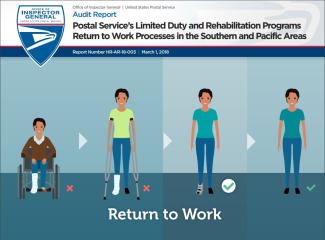USPS’s Limited Duty and Rehabilitation Programs Return to Work Processes, Southern and Pacific Areas
Objective
Our objective was to assess whether the U.S. Postal Service effectively managed its Limited Duty and Rehabilitation programs to ensure that injured employees in the Southern and Pacific areas who were deemed fit returned to work timely.
The Postal Service’s Limited Duty and Rehabilitation programs help the agency meet its legal obligation to injured-on-duty employees, including the requirement to return them to work within their medically defined work restrictions. These programs accommodate employees who are temporarily unable to perform their regular job and assist employees with permanent disabilities.
The Postal Service tracks employees who are deemed fit to return to work in a limited duty capacity via its No Work Available (NWA) list; however, there are no assignments available at this time. On May 17, 2017, there were 1,243 employees on the NWA list nationwide, 489 of whom were in the Southern and Pacific areas.
What the OIG Found
The Southern and Pacific areas effectively managed Limited Duty and Rehabilitation programs to ensure that injured employees deemed fit to do so returned to work. For fiscal year 2017, Quarters 2 through 4, these areas returned 1,094 employees from the NWA list back to work; however, opportunities exist to strengthen controls and efficiency in program processes.
We statistically selected and reviewed 45 percent (222 of 489) of employee case files from the NWA list for the two areas and found the following deficiencies:
■ Thirteen percent (28 of 222) of the case files did not have updated medical documentation reflecting the employee’s current work restrictions.
■ Twenty-seven percent (59 of 222) of the case files did not have evidence of completed work searches to identify limited duty assignments for employees deemed fit to return to work.
■ There was no special job bank available to serve as an automated work search option or repository of available work assignments for limited duty employees.
■ The Employee Health and Safety system (EHS) did not accurately reflect the work status information for 16 percent (35 of 222) of the case files.
■ Forty-two percent (five of 12) of the case files related to employees who refused job offers or accepted rehabilitation assignments that resulted in an employee’s compensation not being properly adjusted to reflect the change in work status.
These issues occurred because (1) Health and Resource Management (HRM) specialists were unaware of or did not use available reports to manage medical documentation, (2) controls were not adequate to validate that work searches were conducted and/or documented, (3) management deactivated the special job bank, (4) EHS system did not have a work status option to identify all employee statuses, and (5) HRM specialists did not properly notify the U.S. Department of Labor (DOL) of changes in employees’ work status.
As a result, these issues had a potential negative impact on the timeliness and efficiency of returning injured employees back to work.Additionally, there was a total of $68,200 in compensation provided to employees for which they were not entitled.
What the OIG Recommended
We recommended management provide EHS system — 546 report training; assess if the staffing to caseload ratio aligns with requirements established by management; implement a control to validate that work searches are conducted; assess the feasibility of implementing an automated or other solution to promote process efficiency and satisfy the special job bank requirement; develop a methodology to include accurate work statuses in the EHS system and provide training; and reiterate the DOL adjudication policy and guidance.

